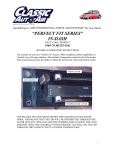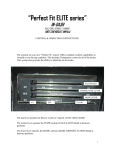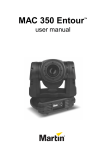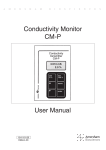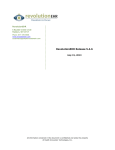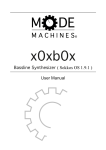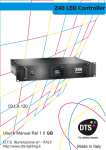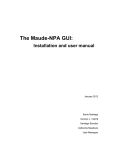Download Classic AutoAir 1971-1973 Mustang A/C system Operating instructions
Transcript
specializing in “AIR CONDITIONING, PARTS AND SYSTEMS” for your classic vehicle PERFECT FIT SERIES” IN-DASH HEAT/ COOL/ DEFROST 1971-73 MUSTANG CONTROL & OPERATING INSTRUCTIONS The controls on your new “Perfect Fit” system. Offers complete comfort capabilities in virtually every driving condition. This includes Temperature control in all of the modes. This system also provides the ability to blend the air between Heat, and Defrost modes. MODE LEVER FAN SWITCH TEMPERATURE LEVER THE PICTURE YOU SEE ABOVE SHOWS THE CONTROLS IN THE FLOOR MODE. THIS MEANS THAT THE AIR WILL BE DISTRIBUTED THROUGH THE FLOOR OUTLETS. THIS ALSO HAS THE TEMPERATURE LEVER IN THE COLD POSITION. WITH THE CONTROLS IN THIS POSITION YOU WILL GET THE AIR THROUGH THE FLOOR OUTLETS AT ROOM TEMPERATURE. 1 CAUTION: ALL OF THE OUTSIDE VENTS MUST BE CLOSED WHEN THE SYSTEM IS IN THE A/C MODE. THIS WILL ALLOW THE A/C SYSTEM TO FUCTION AT ITS MAXIMUM PERFORMANCE LEVEL. THE FOLLOWING SUMMARY WILL DESCRIBE EACH OF THE CONTROL LEVERS FUNCTION. FAN SPEED SWITCH: There are 3 speeds plus Off. When the switch is in the off position it will disconnect the 12V power to the Blower Motor and the A/C Clutch. This will shut down the entire system. When the switch is moved to any of the blower speeds 1,2 or 3 there is 12V supplied to the Micro-Switch which is mounted on the defrost air housing. FLOOR / FACE / DEFROST MODE: When the top lever is pulled all the way to the LEFT, it will direct the air to the floor ducts. When the lever is moved into the CENTER position the air is directed to the Dash Louvers. When the lever is pushed to the far Right, the air will be directed onto the defrost outlets. When the lever is in the Defrost position the A/C Compressor is activated and provides Dehumidification. TEMPERATURE CONTROL: The temperature lever as shown is in the COLDEST temperature position. As the lever is pushed to the right the temperature of the discharged air will rise to the HOTTEST point. Note: The temperature lever will function in any of the modes. AIR CONDITIONING MODE: The picture shows the controls in the Floor Mode (air-flow out the floor outlets). When Air Conditioning is required the compressor clutch must be activated. This is accomplished when the top lever is in the Center position. When the compressor is activated the Temperature Lever will control the air from maximum cold through maximum heat. 2 specializing in “AIR CONDITIONING, PARTS AND SYSTEMS” for your classic vehicle INSTALLATION INSTRUCTIONS 1971-73 MUSTANG Congratulations! ! You have just purchased the highest quality, best performing A/C system ever designed for you Classic Car. To obtain the high level of performance and dependability our systems are known for, pay close attention to the following instructions. Before beginning the installation check the box for the correct components. Evaporator Face Duct Assembly Defrost / Heat Duct Assembly Inlet Air Block Off Assembly Firewall Block Off Assembly Flex Hose 2 ½”dia. (1) 2’, (2) 3’ Flex hose 2”dia. (2) 2’ Sack Kit Hardware Sack Kit Control Glove box IMPORTANT INFORMATION 1. 2. 3. 4. 5. 6. 7. 8. 9. Before starting, read the instructions carefully and follow proper sequence. Check condition of engine mounts. Excessive engine movement can damage hoses to A/C, heater, radiator, transcooler, and power steering systems. Before starting, check vehicle interior electrical functions. i.e. interior lights, radio, horn, etc. When ready to start installation, disconnect battery. Fittings. Use one or two drops of lubricant on O’rings, threads and rear of bump for O’ring where female nut rides. Do not use thread tape or sealants. Always use two wrenches to tighten fittings. Try holding in one hand while squeezing together while other hand holds fitting in position. Shaft seals in a small percentage of compressors will require as much as 3-4 hours run time to become leak free. Compressors supplied in our complete systems are filled with proper amount of oil. Compressor requires technician to hand turn 15-20 revolutions before and after charging with liquid from a charging station before running system. Compressors with damaged reed valves cannot be warranted. Should you have any technical questions, or are suspect of missing, or defective parts, call us immediately. Our knowledgeable staff will be glad to assist you. 3 YOU CAN NOW BEGIN THE INSTALLATION Remove Glove box, Radio (with bezel), center console if equipped, set aside for reinstall. Retain original hardware. CONSOLE RADIO / BEZEL GLOVE BOX Removal of the Original Heater Assembly can be accomplished by disconnecting the two control cables. One attached to the Temperature door. Electrical harness Disconnect electrical harness. Temperature door One attached to the Heat / Defrost door as shown. Heat / defrost door 4 Attachment Screw Discard Locate on the passenger side and remove the following components. Fresh air inlet box, Fresh air transition duct, and the Push Pull cable. Discard along with all of the hardware. Air Inlet Box Discard Remove attachment screw and clip located in front of air inlet. (3) #10 Nuts / Discard Fresh Air / Transition Duct / Discard On engine side of the Firewall remove the (4) screws as shown. DRAIN COOLANT FROM RADIATOR. Remove Heater hoses from heater coil at firewall. (4) ¼-20 nuts Remove amd Discard Locate defrost duct from the heater box to base of the defrost distribution plenum. Use sharp box knife and carefully trim duct assembly flush with flange as shown. Trim to flange. 5 Remove control head. Disconnect control cables, and blower switch , discard. Retain all of the original hardware. Remove the complete Heater Assembly and discard. Locate on the drivers side the Fresh Air Inlet Box. Locate the transition duct between the inlet box and the louver in the Instrument Panel. Remove transition duct only and discard. NOTE: Drivers side air inlet box is same as passenger. Reference picture page 3. NOTE: There is a template provide on page 26 of these instructions Looking through the glove box opening locate the 1 ¼” dia hole that the heater connection extended through. Also locate original hole that the heater assembly mounted through. Drill and cut the holes as shown below. 1 ¼” original heater connection hole. 4” dia. Hole. Original hole Drill 5/16” dia. 5/8” dia. Hole NOTE: INSTALL (2) 1 ¼” CAP PLUG OVER ORIGINAL HEATER CONNECTION HOLES. 5/8” Dia. hole. Brake line Caution: on the engine side of firewall there is a brake line. Do not drill through. It may be necessary to carefully relocate this line. 6 Picture to the right shows center louver as it will later be installed. In order to install the louver properly the pocket in the Instrument Panel above the gauges needs to be modified as shown in the picture below. Open the back wall as large as possible. Locate original wiring harness that was connected to the original blower switch. From the plug cut the brown wire and attach a ¼” insulated male spade connector. 7 All modifications to the vehicle are complete. You can now begin installing your Classic Air “Perfect Fit Series” System. Locate the original control head. In the control sack kit you will find the control switch mounting bracket. Attach bracket using original screw that holds rear section of control head to the front section. Locate the new Blower Switch, and (2) #6 x 3/8” Pan Head Screws. Attach switch as shown below. Locate knob in control sack kit and install over switch shaft. 8 Locate in the control sack kit (2) cables. Longest one is for the Temperature lever . Attach this with (1) #8 x 5/8” pan head philip screw and the cable clamp provided. Short cable is attached to the mode control lever. Hold cable over edge of the control head as shown below. Mark and drill a 1/8” Dia. hole and attach the cable with (1) #10 x 5/8” pan head philips screw. CABLE CLAMP Drill 1/8” Dia hole. Set aside for later installation. ¼-20 J-clip Locate the Inlet Block off Plate. Located above the glove box opening place block off plate over the hole. Attach with (2) #10 x ¾ “ hex washer head tek screws. Place ¼-20 J-clip over mounting flange as shown. 9 Locate Defrost Duct Adaptor from the Hardware Sack Kit. Place over the defrost duct that was previously modified. Attach using (2) #10 x ¾” hex washer head tek screws. Locate Evaporator. Slide evaporator up into place behind the glove box opening. From the engine compartment attach the evaporator using ¼ - 20 x 5/8 hex head screw with ¼” washer through the 9/32” Dia. hole previously drilled. Behind glove box opening attach the blower support bracket as shown. ¼ - 20 x 5/8” with 1/4 “ WASHER 10 Attach with (1) ¼ - 20 x 5/8” hex head screw into the J-clip previously installed. Behind the J-clip you will find an additional hole in the support bracket. Install a #10 x ¾” hex washer head tek screw through this hole and into the cowling. Locate in the hardware sack kit the evaporator Support Bracket. Remove bolt from the instrument panel support brace and slide Support Bracket behind and reinstall the bolt. Attach other end of the bracket to (2) 1/8” Dia. holes in front of the evaporator using (2) #10 x 5/8 pan head Philips screws.as shown. Tighten all screws. Locate Firewall Block Off Plate. On engine side of the firewall attach over hookup tubes from the evaporator using (2) #10 x 5/8 “ hex washer head Tek screws. Locate insulation tape provided and seal around hookup tubes as shown. Water Valve / (3) hose clamps. 11 Locate the Water Valve and (3) worm gear clamps. Supply line from the engine is attached to the lower heater hookup tube. Cut 6” off the end of the return line and install the water valve using (3) worn gear clamps as shown above. See technical data sheet on page 22. Note: It is recommended that you replace heater hoses from the engine to the hookup tubes. Locate the ½” Dia. x 6” long piece of clear drain tube. Insert through 5/8” Dia. hole previously drilled and attach over drain nipple on the evaporator. Using the insulation tape seal around tube. Locate Defrost / Heat Duct Assembly. Attach to evaporator using (2) #10 x 5/8 pan head Philips screws. Be sure that the S-clips are pressed over the rear flange. This helps secure the duct assembly. Locate 2” Dia. flex hose cut off (2) pieces 2’ long and attach to top of the defrost / heat duct assembly. Attach other end to the Defrost Duct Adaptor as shown. 12 BLUE WIRE FROM BLOWER SWITCH BLUE WIRE TO THE THERMOSTAT Locate wire harness from the evaporator electric actuator and attach to the (2) micro switches. Refer to the wiring diagram on page 21. Attach Wire Harness supplied in unit to the blower switch. Route harness through the control opening. Attach wire harness to left micro-switch on the Defrost Duct assembly. Route the harness across top of the unit and hookup resistor, and blower motor. Route the blue clutch wire over evaporator and out through hole in the firewall block off plate. Secure ground from electronic actuator and blower motor using (2) #10 x ¾ “ hex washer head Tek screw. REFER TO THE WIRING DRAWING FOR PROPER CONNECTIONS. Connect power wire (brown / from original harness) to the Red / White stripe from the new harness supplied. 13 14 Route longest of (2) cables that were attached to the control head, around behind evaporator assembly and out through upper hole that original heater was fastened through. Attach this cable to the water valve. Set control lever in the Cold position and be sure that the water valve is closed. Locate insulation tape and seal around cable at firewall. Route shortest of (2) cables and attach to the defrost / heat duct. Insert cable into second hole from the bottom. Attach using (1) #10 x 5/8” pan head philips screw. Reinstall controls into the instrument panel using original hardware. Locate the Face Duct Assembly. Attach to the evaporator. There are s-clips on back edge of the face duct. Make sure that they slide over the flange on the evaporator. Attach using (2) #10 x 5/8” pan head phillips screws. #10 x 5/8” pan head philips screw 15 Locate the 2 1/2 “ Dia. flex hose. Find (1) piece 2’ long. Attach to the face duct over the left outlet as shown on the picture at bottom of page. 2 ½” Dia x 2’ Route hose up through the hole previously cut in instrument panel above the gauges. Locate the Center Louver and attach duct hose as shown. Carefully push louver assembly into the opening. Locate the 2 ½“ Dia. flex hose. Find (2) 3’ pieces. Also locate the (2) louver adaptors from the Hardware Sack Kit. Attach each one onto each of the 3’ flex hose. Using (2) #10 x 5/8” pan head phillips screws. Attach one of the ducts to the right outlet on face duct assembly. Route over glove box opening and push over the passenger outlet. RIGHT LEFT 16 2 ½ “ x 3’ flex hose 2 ½ “ Dia x 3’ flex hose Louver adaptors Passenger outlet. The second of the flex hose assembly attach to the side outlet of the face duct assembly. Route up and behind instruments and over to drivers outlet. Install over drivers outlet. Refer to the picture above. Reinstall the Radio (and Bezel) and the center console if equipped utilizing original hardware. Locate the New Glove Box supplied in kit. Slide through opening as shown. Place trim bezel and glove box door in place and attach using original hardware. 17 Caution: Carefully check under the Instrument Panel for all cables, electrical harness, or Flex Ducting that might interfere with the safe operation of the vehicle. Make sure that you cycle the Windshield Wipers to insure proper clearance of mechanism. INSTALL THE COMPRESSOR AND MOUNTING HARDWARE USING INSTRUCTIONS SUPPLIED WITH KIT. BE SURE THAT COMPRESSOR IS INSTALLED WITH FITTINGS 90 Deg. FACING DRIVERS SIDE FENDER. Remove the following components Center Hood Latch Assembly, and the (2) horns. Retain original hardware. Set aside for reinstallation. Locate the Condenser Coil, (4) Condenser mounting brackets, (10) #10 x 3/8” screws, Drier assembly, mounting bracket and liquid tube. Attach drier to the coil using the liquid tube as a locator using (2) #10 x 3/8” screws. Attach the tube to the coil and drier using (1) #6 o-ring on each fitting and a few drops of mineral oil. Tighten fittings. Be sure to use backup wrench on condenser fitting. Loosely attach the (4) mounting brackets to the condenser as shown. Use (8) 10 x 3/8” screws. 18 Slide Condenser Assembly into place as shown. The lower attachment locations should line up with holes already in the radiator support. Attach using (4) #14 x ¾” tek screws. Tighten all screws. Locate dimple in radiator core support just to the left of the opening for the tubes to pass through on the drivers side. Drill a 3/16” diametre hole using the dipple as the center. 3/16” HOLE Locate the Liquid Tube, and the Discharge Tube. Using (1) #6 o-ring and a few drops of mineral oil attach liquid tube to drier and pass through the opening in the radiator core support. Using (1) #8 o-ring and a few drops of mineral oil attach discharge tube to the condenser and pass through the opening. 19 Locate tube support bracket, spacer, (1) #10 x 1” machine srew and nut. Attach bracket over tubes. Insert screw through bracket, spacer and then through previosly drilled hole. Attach using the #10 nut. Locate Hi / Low switch and electrical boot. Attach this to the drier using a few drops of oil on the connection. Route wires along the discharge tube into the engine compartment. Reinstall the following components: Center Hood Latch Assembly and (2) horns. DISCHARGE HOSE Attach Liquid Hose to the #6 condenser tube and route along the tower supports and connect to the #6 fitting on the firewall. Use (2) #6 o-rings and a few drops of mineral oil. Attach the disharge hose to the discharge tube and then to the compressor. Use (2) #8 o-rings and apply a few drops of mineral oil. Tighten all fittings. LIQUID HOSE 20 Locate the Suction Hose. The hose has (2) 90 Deg. fittings pre-attached in the correct position. One of the ends has a service port, this should be attached to the compressor. The other end will attach to the suction tube coming from the evaporator assembly. Use #10 o-rings and apply oil before attachment. Tighten all fittings. Suction hose Liquid hose Carefully route liquid and suction hoses Locate female bullet connector that is supplied with the Hi-Low pressure switch. Cut one of the white wires from the pressure switch. Attach the bullet connector to this wire and plug into the compressor clutch wire. Route the long white wire from the pressure switch along the suction hose and connect to clutch wire that was inserted through the firewall. Use ty-raps supplied and attach hoses to the tower supports. Congratulations you have completed the install of your CLASSIC AUTO AIR “Perfect Fit Series” system. 21 THE ENGINE COMPARTMENT OF YOUR SYSTEM IS COMPLETE. THE UNIT IS READY FOR EVACUATION AND CHARGING. THIS SHOULD BE DONE BY A QUALIFIED AND CERTIFIED AIR CONDITIONING TECHNICIAN. NOTE: COMPRESSOR IS SUPPLIED WITH THE CORRECT OIL CHARGE. DO NOT ADD OIL TO SYSTEM. 134a SYSTEMS 24 oz OF REFRIGERANT Recommend that power fuse is 25 amp minimum. 22 23 IMPORTANT CAUTION: WATER VALVE MUST BE INSTALLED PER THE INSTRUCTIONS. Classic Auto Air has done extensive testing on the correct method to install the water valve in order to get a repeatable and progressive temperature control. Locate the bottom connection from the evaporator/heater unit off of the firewall and attach a 6” piece of 5/8” dia. heater hose with the supplied hose clamp. Next attach the inlet side of the water valve using another supplied hose clamp, (make sure the arrow on the water valve points toward the engine) Attach a heater hose from the outlet side of the water valve and route to the connection on the water pump. NOTE: WATER VALVE = WATER PUMP FROM HEATER CORE TO WATER PUMP COOLANT FLOW CAUTION: WATER VALVE MUST BE INSTALLED ON HEATER LINE ROUTED TO WATER PUMP. NOTE: COMPRESSOR PURCHASED WITH KIT IS SUPPLIED WITH THE CORRECT OIL CHARGE. DO NOT ADD OIL TO SYSTEM. 134A SYSTEMS 24 oz OF REFRIGERANT Recommend that power fuse is 25amp minimum 24
























